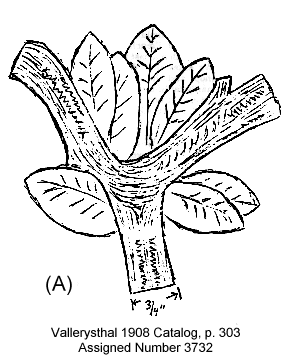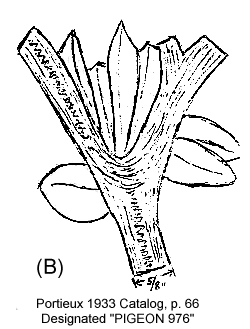by Frank Chiarenza
The Robin on Pedestal Base (Ferson 3) is among the best known of the French animal covered dishes, owing largely to the abundantly available reproductions made by Westmoreland. It may come as a surprise to you, as it did to me, to discover that even the French original of this piece is found in two different versions. Moreover, I believe we should recognize that several other covered dishes made by the two affiliated French glasshouses – Vallerysthal and Portieux – though superficially appearing to be identical were actually pressed from different molds. Among these I would include variants of the Dolphin and Shells, the Beehive, the Squirrel on Acorn, the Swan, and the Crouching Rabbit covered dishes. All of these, and perhaps others, can be found in more than one version. They may differ not only in overall dimensions but in detailed features, sometimes subtle, not to mention differences in the quality and characteristics of the glass mixture.
One of the early references to the Robin on Pedestal appears in Ruth Webb Lee’s Victorian Glass (copyright 1944), where it is shown in plate 116, together with the same Robin cover set on a round basketweave base. Lee states that these and other Vallerysthal animal covered dishes were produced “along about 1936 and until 1939. Some of them,” she continues, “have ‘Vallerysthal embossed in the bases and others are unmarked. The bird [shown in plate 116] is in opaque blue and is marked. I purchased it in a gift shop” (p. 324).
Although we have no reason to question Lee’s assertion that the Robin she purchased in a gift shop may have been produced in the 1930’s we know that it was made in the pre-World War I period, as it appears in a Vallerysthal catalog dated 1908, where it is assigned the factory number 3732 and is shown among a group of items designated “Sucriers” (covered sugars).
That this Robin was also produced at the Portieux factory is attested in its 1933 catalog where it is shown on page 66, designated “Pigeon” and assigned the number 976. Incidentally, in that catalog the Robin is shown between the Standing Rooster and the Wicker Basket – all of which were later reproduced by Westmoreland.
In an unsigned editorial essay, “Vallerysthal Glass,” which appeared in The Spinning Wheel for April 1951, the Robin on Pedestal is shown and described as “a very complicated bit of glass pressing” – a colossal understatement! To describe in detail the features of this covered dish would challenge even the verbal dexterity of Minni Kamm! And today, we have at least four different versions of the Robin on Pedestal to contend with: two French ones, the Westmoreland reproduction of one of them, and a Taiwan product which can at best be called an approximation. We may examine some of the major distinguishing features of each of these Robins, beginning with the two French originals.
In my collection I have a signed Vallerysthal Robin in clear crystal and several unsigned ones in opaque (blue and white) bearing the round P.V. FRANCE sticker. In my experience, I have never found any opaque specimens that are marked either Portieux or Vallerysthal, but of course they must exist, as Lee indicated that her blue opaque Robin was marked. The Fersons also state that the one they show (Ferson 3) is marked MADE IN FRANCE. It would really be helpful for members to examine the ones in their collections and report to the publications committee what kinds of marks or stickers appear in their French Robins, and whether they conform to the Vallerysthal or Portieux versions as described below.
In comparing my signed Vallerysthal Robin with those in my collection which I take to be unsigned Portieux products, I have found they differ in a number of ways. The Robin covers are very similar overall, differing mostly in the mold detail of the head. Vallerysthal’s version has a somewhat larger beak, and the feathering along the top and sides of the head is much more deeply pressed, each separate band being more clearly delineated than in the Portieux version. Also, the sides or “cheeks” of the Vallerysthal Robin are fully rounded and plump; Portieux’s are a bit flatter with a fairly well defined “dimple” on the left cheek.
The pedestal bases, too, appear quite similar until one examines the undersides, and then the differences are striking. In the accompanying sketches you will see that both bases have the same overall configuration – a forked branch with a single leaf on one side, two leaves on the other, and four closely overlapping leaves clustered within the forked area. But beyond that, even a quick look will reveal obvious differences in the molds that produced the two versions. Curiously, when viewed from the upperside, the differences are less apparent; the topside details of branches and leaves are much more alike than they are on the underside.
There are also other less easily sketched or described differences in the main body of the base (the nest itself). Production of this piece must have required some considerable hand finishing, especially in folding back the large leaves that protrude around the nest and the twigs or strands of straw that project at the top. The direction in which the leaves are folded back, for example, will affect whether the molded veins appear on the outer or inner surface of the leaves. My Vallerysthal Robin has its leaves folded back so that the outer surface is smooth; the Portieux specimens are folded back in the opposite direction so that the veins can be seen and felt on the outer surface. Again, with all such attempts to describe minute and complicated differences, a hands-on examination is really the best way to discern the differences. And with a piece as ornately molded as this, it may be the only good way.
Now, when we examine the Westmoreland reproduction and compare it with the two French versions, there can be no doubt at all that Westmoreland reproduced the Portieux Robin. The underside of Westmoreland’s pedestal base looks exactly like the version “B” in the sketch. It also has most of the other features that distinguish the Portieux original: a sort of “dimple” in the left cheek; leaves around the nest folded back so the veins can be seen; feathering around the head rather faint; and in all other respects, unmistakably a Portieux, not a Vallerysthal copy. Incidentally, when signed, the Westmoreland WG-logo will appear on the inside of the cover and on one of the side branches of the underside of the base.
Did Westmoreland actually acquire the original Portieux mold? Not very likely. The Robin, as well as other French pieces, was used as the model from which a cast was made to create a new mold. We know that Westmoreland had its own mold shop and the molds it produced were extraordinarily faithful to the originals. It is only my assumption, but one which I believe has plenty of substantiating evidence to support, that Westmoreland began to seek out all of the French pieces that looked to be potential good sellers. Besides the Robin, Westmoreland reproduced the Wicker Basket and Cover (No. 26); Shell & Dolphin (No. 1048); Ribbed Candy Jar (No. 1887); Standing Rooster (No. 6); the unnumbered “Hand Vase”; and possibly others – beginning in the late 1940’s and early 1950’s. Mr. John Schupp, Westmoreland’s production manager, recalls Mr. Brainard’s having traveled to France in that period, and it is not unlikely that finding these French pieces attractive, he returned with specimens from which his molds were made.
We may recall, too, that during the 1950’s a large group of some 38 recognizably Portieux products were being imported and sold by Mitteldorfer Straus, Inc. The Robin cover set on a round basketweave base is among them, though not the version on the pedestal base. (See OPAQUE NEWS for April 1987, reproducing information from Glass Review, September 1979.)
A notable difference between the Westmoreland Robin and both of the French ones is that the Robin’s head of the French versions is solid. The Vallerysthal one shows a deep crease, the Portieux one a round flat surface at the base of the solid head. The head of Westmoreland’s Robin, on the other hand, is hollow; you can insert your little finger up into it. It may be that Westmoreland’s heavy glass proved to be a problem in the cooling process, as the head would tend to sag and had to be made lighter.
Finally, more recent foreign reproductions of many animal covered dishes abound, including versions of the Robin both on the pedestal base and on a round basketweave base. Grist (plates 111, 114, and 115) shows the Robin on its round base in opaque blue, a sick pink and a purple slag. It is difficult to be sure whether the Taiwan versions a copy of Westmoreland or of the Portieux original, as the underside more closely resembles the pattern of sketch “B”.
Jim Slater has several Taiwan specimens of the Robin and has supplied the following information. Like the French ones, the Robin’s head in the Taiwan copies is solid, with either only a shallow concavity or just a slit-like depression. Jim also notes differences in the knobs or twigs that protrude around the nest, and differences in the width and depth of the rims on which the cover rests. Moreover, the four leaves within the forked- branch show some distortion both in dimensions and degree of overlapping, with the branch “squeezing out” the two right leaves of the cluster within the fork. Before the Heisey society threatened to sue, many early Taiwan specimens of this and other covered dishes were marked the an “H” inside a diamond. In any case, most collectors will agree that the best indicator distinguishing all these late reproductions is not merely the inferior quality of the glass itself. but the mold details which are generally crude and botched.
Again, I urge members to send a note to the publications committee reporting their finds upon examination of their French Robins on Pedestal Base, especially if there are corrections of, or additions to, my observations. One of the benefits of our society should be the opportunity of collaborative research!



